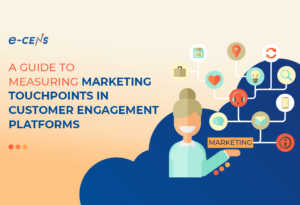Digital maturity represents the sum of your digital capabilities in terms of delivering connected, multi-moment marketing, seamless digital experiences, and customer engagement. It relies on adequate technologies, data orchestration, robust data infrastructure, and the skill sets and processes to bring it all together.
For companies trying to move the needle from their current set of digital capabilities to one more in line with what is possible and expected in the marketplace, frequently incremental change is not enough. This is where digital transformation comes into play: large-scale enhancements to an organization’s digital capabilities built on the pillars of technology, data infrastructure, processes, and people.
Ultimately, it is a form of organizational change, and because it is likely to impact people and processes as much as martech and data infrastructure, there is a big part of digital transformation that involves some of the same psychological and sociological factors of all organizational change.
The scale of change, the cost of the investment, and the time dimension of digital transformation together make a perfect recipe for exceptional leadership to shine. Conversely, it is a recipe for disaster where strategic leadership is absent or where poor leadership is not shepherding the process.
Here are 3 things for driving successful digital maturity:
1) Business Alignment
2) The Time Dimension
3) Organizational Change
Business Alignment
For digital transformation to be successful, business alignment is table stakes. You must start out any large-scale organizational change that impacts multiple teams, divisions, and key stakeholders by accomplishing (at least) two goals:
- Providing a compelling and strategic vision for why the change is needed and what benefits it is expected to bring to the company overall
- Why is the change deemed necessary, and why is it being undertaken?
Good leadership secures stakeholder buy-in early in the process before key decisions have been made and locked in (e.g. architecture, solution design, vendor selection, business requirements, etc.): if for some reason you’ve decided to move forward with all of this and make final decisions ahead of time, don’t waste time around stakeholder input and feedback. Transparently communicate what has been decided on and why, and do not create the illusion that people have a say into things they don’t.
Provide clear and reasonable expectations around timelines, impacts on productivity and stress, and make sure that you do not pressure the teams executing on these initiatives into timelines destined to fail. Digital transformation initiatives take a minimum of six months, and eighteen months is not at all unreasonable. Don’t expect to see significant business value out of initiatives as soon as they’ve started or even as soon as an implementation is finished. It takes time to implement systems. It takes time for people to get proficient with new systems. And some platforms (especially martech/adtech) take time to accumulate enough data to run optimally or provide insights.
The Time Dimension
Expanding on the time dimension of digital transformation, let’s dig into this a little bit more.
If you are in a leadership position sponsoring and pushing for improvements in your digital capabilities, consider the business objective you are trying to solve for. This is where a current state assessment can pay serious dividends. It can help you decide if you have one or two incremental changes you need to make to bridge gaps in key areas of the business. Or you may need a much more intensive, transformational journey for your business.
To reiterate what we wrote above: you are in for a bare minimum six month timeframe and much more realistically twelve to eighteen months. Two years is also not out of the realm of reasonable if you are upending your tech stack, your data infrastructure, your ways of working, and the skill sets and roles within your organization. Keep in mind that when you get into two year territory, you risk implementing solutions that can be stale by the time you complete your road map. Designing solutions that are flexible, not locked into specific vendors/tech, and that can swap out components using emerging standards, such as MACH (microservices-based, API-first, cloud-native, and headless) can make your tech and data ecosystem much more robust for the long haul.
Even if your assessment nets out to a conclusion that you just need some incremental changes to bridge one or two capabilities, as an executive sponsor you still need to help set and adhere to realistic time expectations relative to these new investments. As an example, let’s say you decide you need a customer engagement platform (CEP). After all, it is one of the digital capabilities that tends to produce a measurable, impactful ROI for our clients. In the realm of tech maturity, it can provide relatively quick wins. Nevertheless, you should plan for the following:
- Discovery and business requirements gathering
- Vendor selection criteria and selection process
- Solution design
- Onboarding & Implementation
- Training Ramp-up time
You won’t likely be signing a contract for an enterprise worthy customer engagement tool and be seeing a positive return two weeks later. Plan on a solid ninety days to start seeing a really positive impact as your team builds out campaign flows aligned to key customer life cycle segments and puts assets, messaging, offers, flow mappings, and campaigns in-market.
By creating reasonable timelines and holding one another accountable to meeting those timelines, you’ll also build in the required patience to see these initiatives through and start realizing benefits from your investments.
Half-implemented tech and half-utilized tech rarely provide the benefits people expected, but putting technology and marketing initiatives on the shelf as ‘losers’ without seeing things through is not digital maturity
Organizational Change
Large scale organizational change is not easy to tackle well.
Even changes that seem small or trivial to senior leadership impact the immediate, work-a-day productivity of everyone in a company. This is especially true when these changes come as a surprise to people and appear as mandates from on high with little or no advanced notice. This can be as simple as productivity software, communication platforms, or any other piece of software that everyone in the company utilizes.
Every major change requires planning, communication, stakeholder input, and ramp-up time for transitions and onboarding.
How much more disruptive is organization-wide change that involves strategic road maps involving multiple component projects that impact technology stacks, data infrastructure, business processes, and people & skill requirements across the organization.
In our work, we often see C-level executives spearheading these kinds of initiatives from an executive sponsorship and mandate perspective, often with the help of highly paid consultants and other senior leadership in executional roles. Occasionally, we work directly with CEOs, but more frequently we are seeing digital capabilities overhauls driven by CMOs, CTOs, CIOs, Heads of Ecommerce, and other similar roles within the organization.
You don’t need a professional psychologist to lead these initiatives, but if you want your digital transformation to be successful you do need a heavy dose of empathy and emotional intelligence (EQ) to manage organizational change well. As Emily Lawson and Colin Price argued in their 2003 article, “The Psychology of Change Management”, successful organizational change typically requires a shift in mind-set on the part of employees. That doesn’t come from mandates on high but from compelling leadership that convinces people to participate and align to a common purpose. Lawson and Price specified four conditions that should be met:
- Providing a purpose to believe in – “to feel comfortable about change and to carry it out with enthusiasm, people must understand the role of their actions in the unfolding drama of the company’s fortunes and believe that it is worthwhile for them to play a part” (Lawson and Colins 2003).
- Reinforcement systems – “structures and processes that initially reinforce or condition the new behavior do not guarantee that it will endure. They need to be supported by changes that complement the other three conditions for changing mind-sets” (Lawson and Colins 2003).
- The necessary skills to execute the changes – “adults can’t learn merely by listening to instructions; they must also absorb the new information, use it experimentally, and integrate it with their existing knowledge” (Lawson and Colins 2003).
- Consistent role models – “to change behavior consistently throughout an organization, it isn’t enough to ensure that people at the top are in line with the new ways of working; role models at every level must ‘walk the talk’” (Lawson and Colins 2003)
The principles laid out by Lawson and Colins are well-grounded in research and certainly in line with the leadership impacts we’ve seen in successful digital maturity initiatives for our clients.
Communication around the reasons for change is not only helpful, but crucial to help make change management as smooth as possible. When people understand thing like the risk of doing nothing, the benefits expected from the change, the realistic timeframes that account for learning, familiarization, ramp-up to new processes and skills, and the support in place to ease the transition, some of the key stressors of organizational change can me mitigated.
Involving key stakeholders early in the process and making sure that individual team needs and overall business needs are met (or better yet, exceeded) by the upgraded capabilities being designed is another winning component of successful organizational change. That said, there are times when decision-making does not happen this way for a variety of reasons. As leadership, if you choose to make decisions and not involve other stakeholders then be transparent about it, and do not pretend to give people a voice in decisions that have already been made (for whatever reason). If you can be somewhat transparent about why key decisions were made, even better.
Conclusion
By ensuring your strategic roadmap is closely aligned to the business need to upgrade it digital capabilities and that key stakeholders have been consulted early, often, and throughout the planning process, and that you have created project roadmaps with reasonable timelines and expectations around realizing the expected benefits from the investment, senior leadership can effectively articulate the compelling vision behind the large-scale change, can ease the stress and uncertainty that all change brings (and do it with empathy and EQ), and can help provide key leadership throughout the process by rearticulating and keeping the larger objectives, timelines, and benefits at the forefront while the delivery teams are working out the details and execution.
Where enhancing your digital capabilities at a scale that impacts your entire organization is needed, effective senior leadership is an essential component to a successful initiative.
Confused about where to begin? Let’s start with a conversation.




